Menus
- A tri-wheeler called pleasure
- Three cylinders, 4T, 84.6 kW (115.0 hp), 87.5 N.m (8.9 m.kgf), 263 kg, 14,999 euros
- Discovery
- In the saddle
- In the city
- Motorway and expressways
- Departmental
- Part-cycle
- Braking
- Comfort / Duo
- Consumption
- Conclusion
- The video test of the Yamaha Niken
A tri-wheeler called pleasure
Three cylinders, 4T, 84.6 kW (115.0 hp), 87.5 N.m (8.9 m.kgf), 263 kg, 14,999 euros
With the arrival in 2006 of the MP3 125, then available in 300 and 500 cm3, the three-wheeled vehicle has become particularly popular in France.. In particular and above all, because it can be driven by any holder of a car license (B). Faced with the Italian monopoly, Yamaha marketed its Tricity 125 in 2014, redistributing the cards a little with a powerful and light machine, equipped with a more technically refined front axle..
This peculiarity, the Japanese manufacturer is developing today through a new concept of three-wheeled motorcycle based on MT09 and Tracer 900. In love with the Yamaha double front axle? Certainly, by also purchasing at the end of 2017 the patents of the Norwegian manufacturer Brudeli Tech, developer of the leanster models (literally: which leans) 625L and 654L. With probably future projects at stake.
But the Niken is already well anchored in the present and especially on the ground. His Japanese surname is thus: Ni / deux and Ken / saber … A whole program, which Yamaha puts in analogy with the carving ski. Indeed, the desired effect is the same in this technique where the goal is not to conventionally slide the skis to turn but to make them bite the snow to print the trajectory. Like two sabers, the edges of the carving ski precisely trace their trajectory. Like two sabers, the front wheels of the Niken draw their trajectory on the road … Because this is the basis of the concept: how to bring more pleasure and efficiency to the handlebars of a motorcycle with more grip on the front axle? By doubling the guiding train.
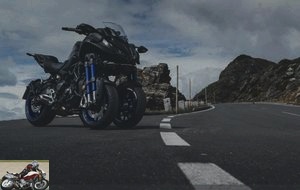 Yamaha Niken test
Yamaha Niken test
It is in Austria, in Kitzbuel that we take the extreme novelty on a winding journey of 300 km, to discover new motorcycling sensations … just that !
Discovery
What’s the fuck? Or, in French: mais diantre, what is it? Because, at first glance, the machine has something to surprise. A motorcycle ? a wine-growing machine? an MP3 under radiation / anabolic cocktail …? No, it’s a Niken! Under this surname quite close to the mythological Kraken, a mutant mechanical being is revealed, totally innovative and unprecedented, in every way. And its equally improbable aesthetic is the first point in a long series of puzzling thoughts..
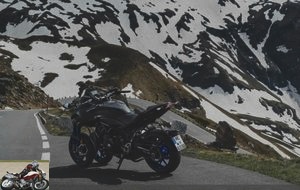 The Yamaha Niken
The Yamaha Niken
No need to answer in positive or negative on the new Yamaha. Even if we say to ourselves that the Dark Side of Japan style, advocated by the manufacturer with tuning forks, may have gone a little far. Just a little bit. The aggressive lines immediately suggest a sportiness specific to the MT range. Because it is on the bases of MT09 and Tracer that the improbable Niken relies. We also find quite well the sharp front features of the roadsters, which then seem very wise, declined on a face much wider. Tapered, framed by daytime running lights, the LEDS optics are surmounted by long deflectors similar to huge eyelashes, mimicking a Kabuki actor’s mask. On both sides, the mirrors incorporating the turn signals seem disproportionate and similar to the antennae of an improbable beetle. A short bubble, unfortunately not adjustable, surmounts the whole. It is especially the shoulders reminiscent of automotive-type wheel arches that are of concern. It is necessary to place the impressive front axle doubled with the important kinematics! Because the machine offers a multi-axle steering technology (LMW: Leaning Multi Wheel) with parallelogram, as on the Tricity, but here oversized and ostentatious. Each wheel is therefore equipped with two juxtaposed inverted fork tubes and placed, on the Niken, on the outside in order to maximize the angle grips (up to 45 °!) … Their bluish finish with electric shine magnetizes the glances and camps with force and confidence the novelty on its front axle.
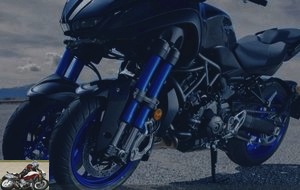 Front axle of the Yamaha Niken
Front axle of the Yamaha Niken
A long 18-liter aluminum tank stretches out towards a large pilot seat. Smaller, with large grab handles, the saddle assigned to the accompanying person is reduced. This rear loop sheaths its structure of taut lines finalized by an angular LED light and rests on a tubular steel structure bolted on two massive aluminum plates linked to the main frame..
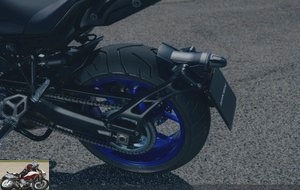 Yamaha Niken rear wheel
Yamaha Niken rear wheel
Dedicated to the Niken, this heavy-section tubular steel element supports the CP3 CrossPlane unit fitted to the Tracer and MT09, of which it incorporates the major characteristics, with optimized injection maps. The 847cc, twin ACT, 12-valve three-cylinder unit features a super-square bore-to-stroke ratio of 78×59.1mm. With its forged aluminum pistons and connecting rods, it also contains high-end mechanics partially modified for the Niken. It develops 115 hp at 10,000 rpm (84.6 kW) and 8.75 da.Nm at 8,500 revolutions-minutes. All available at any speed, without ever weakening as we have seen again during the tests of the Tracer 900 and 900 GT.
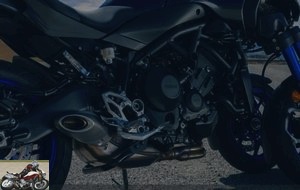 The 3 cylinder CP3 of the Yamaha Niken
The 3 cylinder CP3 of the Yamaha Niken
To find out in detail the specifics of the front axle and find the technical characteristics of the Niken, go to the dedicated section.
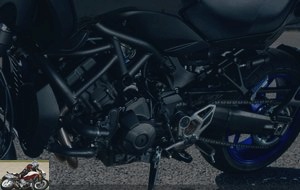 Frame of the Yamaha Niken
Frame of the Yamaha Niken
In summary, the three-wheeled vehicle offers, like the MT09 and Tracer, an electronic accelerator offering three injection maps (D-Mode). They allow the engine response to be adjusted to driving conditions or the rider’s wishes, while maintaining performance. On the Niken, Yamaha renames these modes. No more letters, but numbers: the 1 gives the liveliest character. 2 is the "Standard" profile, sparing sport and touring, mode 3 reduces the response to opening the throttle.
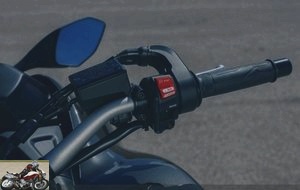 Yamaha Niken throttle
Yamaha Niken throttle
The Yamaha is also fitted as standard with ABS, an anti-dribble and assisted clutch (A&S), a rapid upshift system (Quick Shift System, QSS) without activating the clutch, a traction control (Traction Control System, TCS) with two levels of intervention and deactivatable and a speed regulator. The latter can be operated from 4th and over 50 km / h for long journeys and on motorways. The system is automatically deactivated when braking, clutching or accelerating. In addition, it has a “Resume” button which allows the system to be reset to the previous setting..
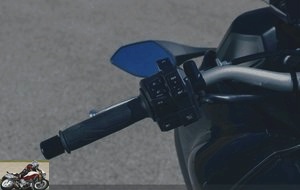 The Yamaha Niken commodos
The Yamaha Niken commodos
The construction is generally qualitative even if we regret that the aluminum tank is not put forward, embedded in plastic fairings of the same color. Likewise, the crankcases do not have the elegance of those of the MT09. Their surfaces display a plain black a little sad and we would like covers masking the rear brake hoses and those of the radiator, the spaces between the engine and the frame and the lower engine. And heated grips could have, perhaps, been part of the lot. Finally, a lower reinforcement of the frame, a not very graceful tube bypassing the catalyst, seems a little incongruous. But a look at the complexity and finish of the front end mechanical elements reveals where all the development attention has been focused. A real mobile sculpture.
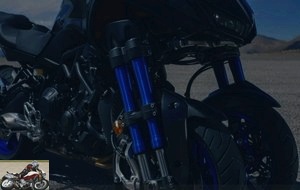 The double forks of the Yamaha Niken
The double forks of the Yamaha Niken
In the saddle
That the front appears wide and far from the pilot …! Because on board too, it’s a change of scenery, the machine almost seems to hold the quad once in the saddle. Large and almost flat, two bosses bear witness to the range of motion of the internal steering arms. The contrast between the unprecedented width of the shoulders and the finesse at the crotch does not fail to impress. However, the tank significantly spreads the legs. Bolted on its plates and not adjustable, the rider saddle is particularly large and long and allows a lot of recoil, ideal for very large. She admits a very accessible 820 mm height. Under the passenger seat, rather small, no carrying space for any gloves or other small business. Compared to its cousins MT09 and Tracer, the Niken displays a much different riding position. Handles and seats are noticeably moved back and lower, the footrests also shift backwards. The legs remain reasonably bent and the body tilts, lightly resting on the large aluminum handlebar with variable diameter: 885 mm, or 35 mm more than that of the Tracer 900.
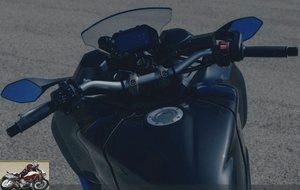 Yamaha Niken cockpit
Yamaha Niken cockpit
Encircling the handlebars, short bridges in the bronze hue pass through a pivoting cap hiding the guiding structure. Dominating the cockpit, the instrument cluster is a large LCD window with negative display. Under the bargraph tachometer, it groups together the tachometer and gear indicator, the driving mode selected (by push-button on the right), TCS level, clock and fuel gauge. On the left stalk a rocker successively scrolls through two partials, odometer, instantaneous consumption, average, engine and exterior temperature. Everything, without frills, is very readable. Note that the TCS traction control only disconnects when stationary.
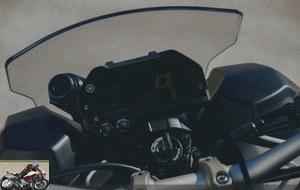 Yamaha Niken speedometer
Yamaha Niken speedometer
We appreciate the presence of a warning control and a brake lever adjustable in spacing. Too bad, the clutch one does not have it. Convenient, a 12-volt outlet is next to the dashboard.
In the city
The mechanics make a loud roar heard recently during the testing of the Tracer 900. Lively and ample, the melody of the three-cylinder block is always attractive. At least one known item. The question at the moment is: how will the machine, which cannot stand by itself at a standstill, launch itself from the reduced space of the parking lot? Well like a conventional motorcycle, proving, from the first meters, an astonishing evidence. No heaviness in this unparalleled front end. We immediately take the measure of the engineering quality that presided over its realization. The balance of the masses of the mobile structure and its intuitive operation testify to a perfect mastery of this technology..
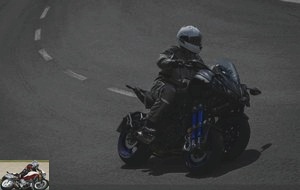 The Yamaha Niken on a curve
The Yamaha Niken on a curve
Whether maneuvering or looking urban, the Yamaha Niken is flawlessly docile. Even the U-turns take place in a rather small space; especially since its specific geometry further facilitates its stability at very low speed. Of course, the width of the front requires a certain anticipation to circulate in traffic, but no more than at the controls of a maxi-trail..
This ease of handling is also due to the smoothness and precision of the controls. It’s hard to believe that this complex steering requires so little effort to operate. In addition, the three-cylinder is of exemplary availability, allowing urban evolutions on the last report at less than 2,000 rpm. Also, the pressure to be applied to the assisted clutch lever is minimal and the gears lock precisely. Finally, the large mirrors return a clear and effective field.
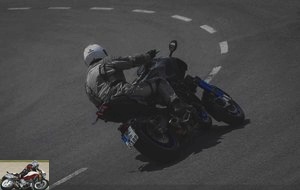 Test of the Yamaha Niken on the road
Test of the Yamaha Niken on the road
Satisfying in the city, the dynamic services of the Niken require more space to appeal more widely. Motorized by a smart mechanic, the machine piaf between the walls while waiting to assert its original cycle part.
Motorway and expressways
Stability is one of the hallmarks of the Yamaha Niken. At the approach of 200 km / h, the machine spins without the slightest oscillation, firmly planted on its two wheels. Each curve taken at high speed reinforces this feeling of control. However, if you let go of the handlebars, the course is not that of a two-wheeled motorcycle. The management then asks for permanent corrections because the geometry of the specific nose gear gently "embarks" the machine on one side or the other..
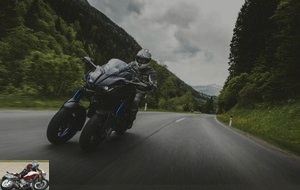 The Yamaha Niken in a straight line
The Yamaha Niken in a straight line
If the bubble provides little deflection, the general width of the machine nevertheless generates an acceptable protection, leaving the shoulders and the helmet more subject to turbulence. But the forward-leaning driving position and the comfortable seating help pass the time. Surprisingly, the imposing mudguards and the double fork do not prevent water projections from reaching the boots and lower legs..
At the legal motorway, the mechanics turned at 5,300 laps, asking to enter one, or even two gears to revive the crew with vigor. To limit boredom on tariffed tracks, cruise control will be welcome. Another solution, to go to the secondary network, the claimed playground of the Japanese maxi tri-wheeler.
Departmental
Before taking the helm of the Niken in the realm of Austrian snow sports and in order to clarify the sensations and ideas relating to the new front axle, Yamaha offered us a few ski descents on glaciers, using carving spatulas. It is true that the analogy with this sport makes sense, as the rocking movement of the skier’s legs can be compared to that of the kinematics of mechanics: inclination of the fork arms when the wheels pivot. On a motorcycle, you tilt on the angle, on the Niken you tilt … And this movement is clearly perceptible, bringing new sensations on a displacement of this type. We will be able to study this point without difficulty: in Tyrol, winding roads and climbs of pass are the norm, an ideal place to "carve" on the road..
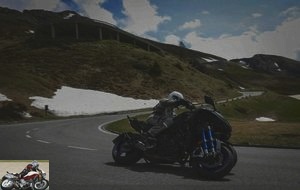 The Yamaha Niken in the laces of Kitzbьel
The Yamaha Niken in the laces of Kitzbьel
The ease of piloting delivered by the novelty Yamaha and the confidence induced by the double front axle allows you to approach the first corner serenely, after a kilometer and the tires barely warm … so serenely that the 45 ° angle is reached and the footrests are copiously scratching the asphalt … Bluffing. It is then really the beginning of a new approach to the road, where one tries to pass as quickly as possible in curves, at each turn. The watchword: adhesion and stability … A real capital of confidence. Especially since the stability on the angle is imperial.
As usual, the CP3 block likes to let out its 115 horsepower stud when the tachometer goes on the attack in its second half of the dial. Granted, they have more to do with the Niken’s 263 kilos. But this engine is full at all speed and will only ask to enter a report to express the ardor of the three cylinders. Thus, tight hairpins require switching to 1 to ensure exits from sporty turns. And, playing the shifter, we then increase the speeds on the fly in the angry and hoarse roar of the exhaust. We can even get a taste for the sliding of the rear wheel, sometimes playing with the limits of grip on the angle..
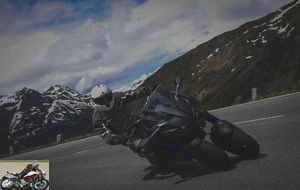 The angle grip is quite important
The angle grip is quite important
The Niken turns out to be a fantastic toy in the winding. Rather well cushioned, its adjustable suspensions easily optimize its behavior. In particular to limit mass transfers. Carried out at a good pace, the novelty ensures high-level dynamic behavior. And, whatever the state of the asphalt, dirty, wet or degraded, we go into a curve as quickly as possible, while keeping in mind that the machine has limits: that of physics. We sometimes feel the front tires slip under control. The additional support and guidance provided by a second wheel greatly limits the risk of ending up with groundhogs. But, in the rain, this could cause you to lose the trajectory, or even the front. But to get there, it will take a real excess of optimism bordering on unconsciousness. You might as well take advantage of the Niken’s qualities more reasonably, trying to feel the work of the tires on a curve. Less noticeable at the start of driving where one imagines rather on a two-wheeler, the habit then makes clearly perceive the particular guidance of the front axle and its so particular and pleasant translation..
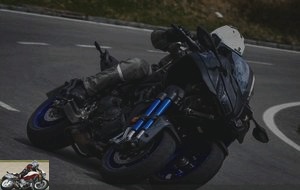 The Yamaha Niken in a corner
The Yamaha Niken in a corner
Part-cycle
Completely innovative and unheard of on the large-displacement market, the Niken’s front axle is surprisingly efficient. Coupled with a perfectly rigid frame, the machine combines precision, comfort and permanent pleasure.
Remarkably suspended, its fork offers a pleasant progression. Once adjusted, the rear handset also offers a good level of comfort and is more homogeneous with the front..
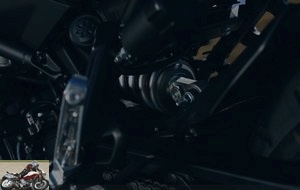 Yamaha Niken shock absorber
Yamaha Niken shock absorber
Braking
With its front discs of smaller size than usual, the maxi three-wheeler may be missing a bit in very sporty use. Progressive implementation of radial callipers ensures good control of decelerations, leaving the pilot to modulate his pressure on the lever. Again, the specific geometry of the Niken offers unusual stability under braking. On the angle, we feel the steering lock slightly and we compensate for the rear brake to let the steering tilt freely and smooth the trajectories. Well calibrated, the ABS is triggered only when wisely, however more noticeably on the propeller wheel equipped with a larger disc.
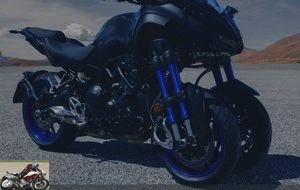 The brakes of the Yamaha Niken
The brakes of the Yamaha Niken
Comfort / Duo
300 km of mountain roads will affect neither your enthusiasm nor your sitting. The pilot seat, perfectly designed, offers surprising and very appreciable comfort. The ergonomics of piloting and the quality of the suspensions confirm well on this point. To travel far, luggage storage should be developed. A high and adjustable bubble would also be on the program.
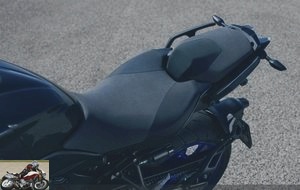 The saddle of the Yamaha Niken
The saddle of the Yamaha Niken
Consumption
According to our survey, the Niken requires less than 7 liters per 100 km when driving engaged. One less unit is quite possible. A very correct score for a machine weighing 263 kilos with the most voluntary mechanics.
 The tank of the Yamaha Niken
The tank of the Yamaha Niken
Conclusion
It is not so common to test a real novelty, one of those machines which can suddenly open a new segment, offer new sensations and make you reconsider your approach to the bike. The Niken is a machine apart, combining technical mastery and dynamic efficiency. On board, we really discover a new way of driving, of taking the angle by mechanical translation, camped on two wheels. The precision of the front axle and its specific kinematics coupled with comfort and sparkling mechanics make the Yamaha a concept apart. Well distributed, its somewhat high masses do not affect the permanent approval of the machine. In the end, we blame it more for the lack of finishing elements and air deflection than any other point of importance..
Keep in mind that few of its components are common with the MT-09 and Tracer 900. Asking € 14,999, the Yamaha Niken offers an unusual efficiency / technology / pleasure / price ratio. To get a clear idea of it, an essay is required for all curious, whether or not we appreciate its distinct aesthetic. If, like the novelty, you are ready to tilt your view of the bike to another angle, the Niken should appeal to you..
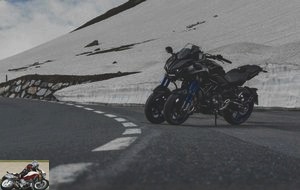 The three-wheeled roadster Yamaha Niken
The three-wheeled roadster Yamaha Niken
Strong points
- Original and efficient front geometry
- Front axle approval
- Engine character and availability
- Agility / stability balance of the chassis
- Ergonomics
- Readability of instruments
Weak points
- No adjustable bubble
- Bubble height too tight
- Heading without hands on the handlebars
- Perfectible finishing details
The Yamaha Niken technical sheet
Test conditions
- Itinerary: winding 300 km route in Austria
- Motorcycle mileage: – km
- Encountered problem : –
The video test of the Yamaha Niken
Related articles
-
The way to serenity 847 cc CP3 engine, 115 hp and 87.5 Nm, steered multi-axles, 267 kg full made, € 16,299 Since 2006, the Piaggio MP3 has masterfully…
-
Comparison test of the Yamaha YZF-R1 and R1M
The easy missile Euro5, 4 cylinders 998 cm3, 200 hp and 113.3 Nm, 201 kg full made, from € 19,299 Each brand has its legendary hyper-sport, its…
-
The MT-09 gets traction control and revised engine maps A new Night Fluo color for this turbulent roadster, from € 8,499 For many years, the mid-size…
-
200 hp at 13,500 rpm, 112 N.m at 11,500 rpm, 199 kilos with full fuel, from € 18,499 Is the Crossplane engine an advantage in road use ? Even if the…
-
Yamaha VMax 1700 motorcycle test
The return of a legend The return of the good, the bad and the tonic-truante. Certain celestial objects cross our orbit according to a periodicity which…
-
MP3 killer? 5 day trial… Xmax Blu-Core single cylinder, UBS full braking, 14 wheels, Bridgestone tires, Smart Key, tilt lock… How to give confidence…
-
Yamaha Tracer 9 and Tracer 9 GT motorcycle test
Cross-country sprinters 3 cylinders in line, 889 cm3, 119 hp and 93 Nm, 213 kg full made, from 11,499 euros Road trail, sport-touring, road … the names…
-
Samba Sambias ! What avid biker has never dreamed of owning and riding a Grand-Prix motorcycle approved for riding on the open road? The Sambiase…
-
Evil Torgnole power 10 New sporty troublemaker in the successful Yamaha range, the MT10 sets new standards in terms of four-cylinder mechanics. Its…
-
Yamaha Tracer 700 GT motorcycle test
Joys of possibilities Twin-cylinder in-line, 689 cm3, 74.8 hp, 68 Nm, 200 kg all full, available in A2, 8,999 euros. The Yamaha Tracer 700 Gt! Here is a…
I thought the same thing: a Ninja 250 from OCCAZ and pouf la Gex ‘.
It’s a shame, because she’s not naughty.
181 kg with full, anyway.
Gone is the advantage of the lightness of a small displacement.
Must see Godzilla. The Ninja 250 weighs around 175 kg with full tank, and it’s a real mob. It is true that its 130 rear gommard has a lot to do with it, but the 140 of the gex cannot make it truckish either..
I would maintain two things:
– for the gex, the mill is clearly too light, and this, for no other reason than the moulbifsistic recycling.
– for less than 500cc in general, the price is far too high in new in our regions, as they say. In the markets for which they were created, they are much cheaper. Are they afraid of no longer selling their ER6, CB 500 and so on, or what?
Completely agree with you, moreover we do not often see them on the road, they sell badly.
I’ve always wondered why, rather than telling us about these novelties, the manufacturers did not open the doors of their catalog to us more than enticing: ZRX 400, Hornet and ZXR 250 (4 cylinders which must howl like it is not allowed in high, yum), VTR 250 ….
Well because the four cylinders had not sold too well with us.
It wouldn’t be much better today.
Because today, for example, we are clamping you a 1090 KTM, which, it seems, would not be so bad to drive even when clamped..
Or to stay reasonable, an MT07 or an ER6 which is more fun than a four cylinder 250 which bawls without moving forward, and which will require a little more maintenance in the long term, and which will be impossible to resell with terminals..
Are not so crazy, the builders.
My little 400 is fun to drive, but with 10hp less, I wonder if it would be of interest…
No doubt yes, with its original suspensions and brakes (end of the 80’s do not forget).
But with a healthier cycle part, it would lack pep.
Part of the interest of the 400 imported into France in the 90s was the weight (since the big ones were heavy, not so much today), and their aesthetics (Ah, the 400 FZR and the VFR … ).

When I see today the face of some bikes not imported from us, finally I say to myself that it is not worse.
I just bought this GSX250R and well this bike is great! A real bike! I have fun despite its 25 hp! Very versatile motorcycle! I ride with it every day! Only negative point IRC tires! I think I will change it soon!
She is pretty and looks tall. Is it possible to do 500 kms in one go?
The winning return of the Blue Fairy of endurance … Powerful and agile racing machine, the Suzuki GSX-R1000R combines spirited mechanics and incisive chassis under the control of perfectly mastered electronics..
To your checkbooks …
The test makes you want to. Even with radars everywhere, even if you don’t do a circuit, it’s still fun to own and walk around on this type of bomb. It’s the ultimate motorcycle somewhere.
Nevertheless, the silencer is the biggest and ugliest that I have ever seen. Intolerable. It is therefore necessary to add 1000 to 2000 € to the price of the motorcycle. (I’m not even talking about aviation hoses, which are essential if only to have a good feeling when braking, which seem to be absent.)
Indeed, in terms of sensations and connection with the road, it’s hard to beat these sports cars. And with the radars, we still play a little cat and mouse…
Regarding the braking, I did not have the opportunity to ride on the circuit with but on the road, power, dosage and feeling are there.,
thank you for following us,
Philippe
Moto а keke in sight !
But if not, it’s kind of exactly the bike that I don’t need: full of cylinders (why?), Full of valves (why?) Full of chwo (again, why?), A fairing that is not used nothing (and the optics resemble that of the old PCX, I allow myself to loler a blow), a passenger seat just there to be ugly, tires too wide and too heavy, indicators as crankcases , and many more.
The worst part is that they will sell bundles of them.
After the Bandit and Bandit S, here are the Scoundrels and Scoundrels S …
It’s an excellent machine, a roadster +. A new category that is more efficient and pleasant.
a lot of quality and an inspiring engine.
It’s an excellent machine, a roadster +.
a lot of quality and an inspiring engine.
I arrive after the battle but we must stop with the TFT screens. Other than testers I have never read / heard anyone claiming a TFT screen.
Personally, I greatly prefer a handset + LCD (Street Triple) or modern LCD alone (CB 650 R) to a TFT: more readable and will age better over time.
The meter is almost identical to the one I have on the SV, and I’m very happy with it, very clear, precise indications. I understand that they keep it. On the other hand, also recovering the obese silencer, was it really necessary?
Original pots are often hideous in the stovepipe genre (a few exceptions though). So yes, when I bought my 700 NCX I changed the pot directly for an IXIL … much more beautiful with the bike. And on my Versys 650 the same, although this is one of the brands that, in terms of the exhaust, has been handling not too badly in recent years.

It’s not to make more noise, just aesthetic.
Gil
Not all Euro 4 approved series silencers are either planted like that in terms of design …
It’s like the z900 a3, it will appeal to those who only look at the "upgrading" side of a motorcycle. It seems that the clamping on the cb650r is much less abrupt than on the one.
There is nothing really shocking about the exhaust. He is even rather stylish.
It seems that the CB650R A2 … it seems … It IS very soft above 6,000 rpm.
This is not the Suz ‘, which asserts a good personality up to almost 8,000 laps. And its torque is much higher than that of the Honda … So the approval is very real.
An essay is better than long unnecessary speeches
Well, isn’t it better to have a good 400 (Kawa Z400 for example), not restrained and which will express itself perfectly. A colleague bought himself a Z900 A2, despite my advice, now he’s crying and picking up his XMAX to come to work. No driving pleasure and a crazy drink with the Z900. You really have to ask yourself the right questions …
I was thinking that an R3 is really effective …